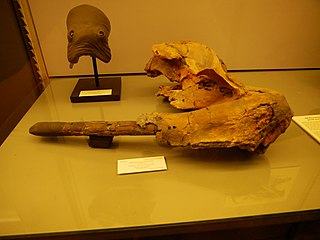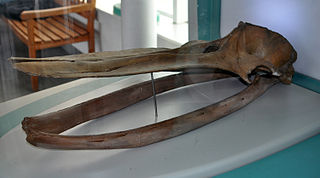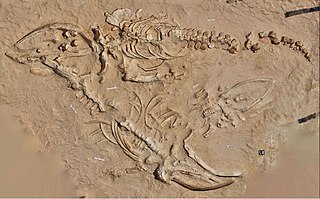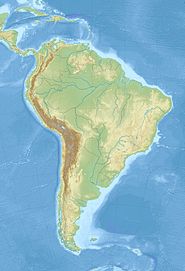
Odobenocetops is an extinct genus of small toothed whale known from Chile and Peru. Its fossils are found in Miocene-aged marine strata of the Bahía Inglesa Formation and Pisco Formation. Two species of Odobenocetops are currently recognized, O. peruvianus and the slightly younger O. leptodon.

Zygophyseter varolai is an extinct sperm whale that lived during the Tortonian age of the Late Miocene 11.2 to 7.6 million years ago. It is known from a single specimen from the Pietra Leccese Formation in Italy. It was a member of a stem group of fossil macroraptorial sperm whales also including Brygmophyseter, Acrophyseter, and Livyatan. It probably grew to be around 6.5 to 7 meters in length and shared some characteristics with other raptorials, such as large teeth with tooth enamel that were functional in both the upper and lower jaws which the modern sperm whale lacks. It also had a beak, the ability to echolocate prey, and could have probably swum faster than the modern-day sperm whale which can reach 4 kilometers per hour (2.5 mph). These were probably used in the capture of large prey, such as large fish, seals, and whales. In fact, its common name, the killer sperm whale, refers to its feeding habits that would have had a resemblance to the modern-day killer whale.
Nothropus is an extinct genus of ground sloth of the family Nothrotheriidae, endemic to South America during the Pleistocene epoch. It lived from 0.781 mya—12,000 years ago existing for approximately 0.769 million years. It was believed to be a ground-dwelling herbivore.
The Mayoan age is a period of geologic time from 11.8 to 10 Ma, within the Middle to Late Miocene epoch of the Neogene, used more specifically within the SALMA classification in South America. It follows the Laventan and precedes the Chasicoan age.
The Chasicoan age is a period of geologic time from 10–9 Ma within the Late Miocene epoch of the Neogene, used more specifically within the SALMA classification in South America. It follows the Mayoan and precedes the Huayquerian age.
The Huayquerian age is a period of geologic time within the Late Miocene epoch of the Neogene, used more specifically within the SALMA classification. It follows the Chasicoan and precedes the Montehermosan age.

Livyatan is an extinct genus of macroraptorial sperm whale containing one known species: L. melvillei. The genus name was inspired by the biblical sea monster Leviathan, and the species name by Herman Melville, the author of the famous novel Moby-Dick about a white bull sperm whale. Herman Melville often referred to whales as "Leviathans" in his book. It is mainly known from the Pisco Formation of Peru during the Tortonian stage of the Miocene epoch, about 9.9–8.9 million years ago (mya); however, finds of isolated teeth from other locations such as Chile, Argentina, United States (California), South Africa and Australia imply that either it or a close relative survived into the Pliocene, around 5 mya, and may have had a global presence. It was a member of a group of macroraptorial sperm whales and was probably an apex predator, preying on whales, seals and so forth. Characteristically of raptorial sperm whales, Livyatan had functional, enamel-coated teeth on the upper and lower jaws, as well as several features suitable for hunting large prey.

Acrophyseter is a genus of extinct sperm whales that lived in the Late Miocene off the coast of Peru comprising two species: A. deinodon and A. robustus. It is part of a group of macroraptorial sperm whales which all shared several features for the purpose of hunting large prey, such as deeply rooted and thick teeth. Acrophyseter measured 4–4.5 metres (13–15 ft), making it the smallest raptorial sperm whale. Because of its short pointed snout, and its strong curved front teeth, it probably fed on the large marine vertebrates of its time, such as seals and other whales.

Piscobalaena is an extinct genus of cetaceans, which lived from the Middle to Late Miocene epochs in Peru and Florida. Its fossils have been found in the Pisco Formation of Peru and the Bone Valley Formation of Florida. At least some individuals of this diminutive whale were preyed on by the shark O. megalodon.

Nothrotheriidae is a family of extinct ground sloths that lived from approximately 17.5 mya—10,000 years ago, existing for approximately 17.49 million years. Previously placed within the tribe Nothrotheriini or subfamily Nothrotheriinae within Megatheriidae, they are now usually placed in their own family, Nothrotheriidae. Nothrotheriids appeared in the Burdigalian, some 19.8 million years ago, in South America. The group includes the comparatively slightly built Nothrotheriops, which reached a length of about 2.75 metres (9.0 ft). While nothrotheriids were small compared to some of their megatheriid relatives, their claws provided an effective defense against predators, like those of larger anteaters today.
Hadrokirus is an extinct genus of true seal (Phocidae) that lived on the coast of Peru and North Carolina about 6 million years ago. The type species, H. martini, was found in the Pisco Formation, together with other marine animals such as crustaceans, sharks, coastal birds, whales and aquatic sloths. The distinguishing feature of the seal was its teeth: they were extremely robust, hence the name. It is assumed that Hadrokirus martini was durophagous; its diet probably comprised crustaceans, small bivalves and other shelled animals, similar to that of the living sea otter. The living seals most closely related to Hadrokirus are the Antarctic seals.

Cerro Ballena is a fossiliferous locality of the Bahía Inglesa Formation, located in the Atacama Desert along the Pan-American Highway a few kilometers north of the port of Caldera, Chile. It has been dated back to the Late Miocene epoch, during the Neogene period. The locality was first noted in 1965 during military work and fully excavated and studied between 2011 and 2012, and is protected by law since the latter year.

The Pisco Formation is a geologic formation located in Peru, on the southern coastal desert of Ica and Arequipa. The approximately 640 metres (2,100 ft) thick formation was deposited in the Pisco Basin, spanning an age from the Middle Miocene up to the Early Pleistocene, roughly from 15 to 2 Ma. The tuffaceous sandstones, diatomaceous siltstones, conglomerates and dolomites were deposited in a lagoonal to near-shore environment, in bays similar to other Pacific South American formations as the Bahía Inglesa and Coquimbo Formations of Chile.

Eionaletherium is an extinct genus of ground sloth from the Late Miocene coasts of Venezuela containing one species: E. tanycnemius.

Tiucetus is an extinct genus of cetotheriid baleen whale known from the Late Miocene Pisco Formation of Peru.

Brachydelphis is a genus of pontoporiid known from the Late Miocene Pisco Formation of Peru and the Bahía Inglesa Formation of Chile.

Balaenoptera siberi is an extinct species of baleen whale from the Late Miocene, described by Pilleri and Pilleri in 1989, based on fossils found in the Pisco Formation of the Pisco Basin in southwestern Peru.

Macroraptorial sperm whales were highly predatory whales of the sperm whale superfamily (Physeteroidea) of the Miocene epoch that hunted large marine mammals, including other whales, using their large teeth. They consist of five genera: Acrophyseter, Albicetus, Brygmophyseter, Livyatan, and Zygophyseter. All species are known by at least a skull, and are informally grouped without a family designation. They were all likely the apex predator of their habitats, comparable to the modern day killer whale, and achieved great lengths, with one species–Livyatan–measuring about 13.5–17.5 m (44–57 ft).

Spheniscus muizoni is an extinct species of banded penguins that lived during the early Late Miocene in what is now Peru, South America. The species, the earliest member of the extant genus, was described in 2007 by Ursula B. Göhlich based on fossils found in the fossiliferous Pisco Formation of the Pisco Basin, southwestern Peru.
Lakukullus is an extinct genus of nothrotheriid ground sloths that lived during the Middle Miocene around 13.8 to 11.8 million years ago of what is now Bolivia.


























